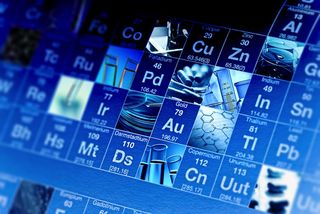How To Fill In Background Of Table In Reactstrap
Filling the Periodic Tabular array: New Names for the Newest Elements

Four new elements take four new names: nihonium, moscovium, tennessine and oganesson.
These names represent to elements 113, 115, 117 and 118, which scientists announced they had institute in January, but had not yet named.
The new names were announced Wednesday (June 8) by the International Spousal relationship of Pure and Applied Chemistry (IUPAC), the organisation that standardizes chemic chemical element names. But don't buy a new periodic table just yet; at that place will exist a five-calendar month window for public comments on the names, subsequently which they will be finalized.
The endings of each of the proposed names (such as –ium) reverberate the element'southward place in the periodic table. The rest of the proper name is specific to each element's discovery, according to a statement that IUPAC issued in recommending the new names. The proposed names came from the labs that collaborated on the discovery of each element, according to the recommendation. [Simple, My Dearest: viii Elements You've Never Heard Of]
"It is a pleasure to meet that specific places and names (country, country, metropolis and scientist) related to the new elements is recognized in these four names," said January Reedijk, who authored the recommendation, in a annotate to the IUPAC.
Nihonium (symbol Nh, element number 113) was discovered at the RIKEN Nishina Eye for Accelerator-Based Scientific discipline in Japan. "Japan" is one way to say "Japan" in Japanese.
Moscovium (Mc, 115) is named afterward Moscow, which is just south of where the experiments discovering information technology were conducted at the Joint Institute for Nuclear Enquiry, in Russia.
Tennessine (Ts, 117) is in recognition of enquiry contributions from the state of Tennessee. This includes work from Oak Ridge National Laboratory, Vanderbilt University and the University of Tennessee.
Oganesson (Og, 118) is named after experimental physicist Yuri Oganessian for a lifetime of work in the field, including research washed at the Joint Institute for Nuclear Research. If the proper noun is accepted, information technology will be one of the few elements named afterwards a living person. Seaborgium, element 106, was named for Glenn T. Seaborg, according to the New York Times. And elements 99 and 100 were named afterwards the physicists Albert Einstein and Enrico Fermi while both men were still alive, co-ordinate to the LA Times. But because of the Cold War, the discoveries of those elements, along with their names, were classified at the time. Both scientists had died by the fourth dimension the information was declassified, co-ordinate to the Times.
Although there may not exist whatsoever major disputes over whether the names properly give credit or recognition where it is due, the public response window will be valuable, given that these names are meant to be used around the world, in many languages, said Cleveland Evans, a professor of psychology who studies names and naming at Bellevue University in Nebraska and chairs the Name of the Year committee for the American Proper noun Society.
"There'south a slight chance that one of these names will resemble something that turns out to be very humorous or bad in another linguistic communication, which would be a good thing to know beforehand," Evans told Live Science. [In Photos: Notorious Retired Hurricane Names]
He noted that naming things subsequently living people is sometimes frowned upon.
"Although these choices may perhaps be viewed by some as slightly self-indulgent, the names are completely in accordance with IUPAC rules," Reedijk said in his comment. IUPAC rules permit naming elements afterwards living people.
"I'thousand quite pleased past them," Geoff Rayner-Canham, a chemist at the Grenfell Campus of Memorial University in Canada, told Live Science in an electronic mail. "They have been agreed upon by all the possible claimants, dissimilar the controversies with alternative names for the same elements in earlier cases." Rayner-Canham has written about the history of scientific discipline and element-naming controversies.
Original article on Live Science.
How To Fill In Background Of Table In Reactstrap,
Source: https://www.livescience.com/55034-new-elements-names.html
Posted by: densonenterce.blogspot.com


0 Response to "How To Fill In Background Of Table In Reactstrap"
Post a Comment